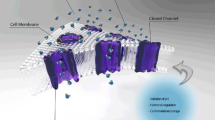Summary
The origin of hypostomal mucous cells during regeneration and budding has been studied inHydra viridis. NormalHydrae were transected at two levels along their body column — sub-hypostomal and mid-gastric — and the cells which participated in hypostome regeneration were identified histologically and with the electron microscope. An earlier paper in this series (Rose and Burnett, 1968b) showed that zymogen cells transformed to mucous cells in sub-hypostomal regenerates. The work reported in the present paper demonstrates that gastrodermal basophilic cells are the primary source of new mucous cells in animals cut in the mid-gastric region. Evidence is presented to support the thesis that these basophilic cells are derived from epidermal interstitial cells. This choice between zymogen cell versus basophilic cell reflects the distribution of these cells along the parent body column at the sites of the transections.
Bud morphogenesis inHydra viridis was also studied because budding provides conditions similar to those of regeneration, and yet, no injury is inflicted on the animal to be studied—that is, a new hypostome must be formed at the distal end of the bud and it must be populated with new mucous cells. The origin of these cells is not from pre-existing mucous cells. The results supported the conclusion that interstitial cells migrate from the epidermis into the gastrodermis of the developing hypostome and differentiate into mucous secretory cells.
Zusammenfassung
Die Herkunft hypostomaler Schleimzellen inHydra viridis wurde während der Regeneration und Knospung studiert. Normale Hydren wurden auf zwei Niveaus ihrer Körpersäule durchschnitten — subhypostomal und mittelgastral — und dann wurden die Zellen, die an der Hypostomregeneration teilnahmen, histologisch und elektronenmikroskopisch identifiziert. Eine frühere Publikation dieser Serie (Rose und Burnett, 1968b) zeigte, daß Zymogenzellen in subhypostomalen Regeneraten sich in Schleimzellen transformierten. Die vorliegende Arbeit demonstriert, daß gastrodermale, basophile Zellen die hauptsächliche Quelle neuer Schleimzellen sind in Tieren, die in der mittel-gastralen Region durchschnitten wurden. Diese basophilen Zellen scheinen von epidermalen Interstitialzellen abgeleitet zu sein. Diese Wahl zwischen Zymogenzellen, resp. basophilen Zellen spiegelt die Verteilung dieser Zellen längs der elterlichen Körpersäule an den Stellen der Schnitte wieder.
Knospen-Morphogenese inHydra viridis wurde ebenfalls studiert, weil Knospung ähnliche Bedingungen schafft wie Regeneration, wobei allerdings das Tier keine Verwundung erhält; d. h. ein neues Hypostom muß gebildet werden am distalen Ende der Knospe, und es muß mit neuen Schleimzellen bevölkert werden. Diese Zellen stammen nicht von prä-existierenden Schleimzellen ab. Die Ergebnisse unterstützen die Schlußfolgerung, daß Interstitialzellen aus der Epidermis in die Gastrodermis des sich entwickelnden Hypostoms wandern und sich in Schleimzellen differenzieren.
Similar content being viewed by others
References
Baird, R. V., Burnett, A. L.: Observations on the discovery of a dorso-ventral axis in hydra. J. emb. exp. Morph.17, 35–81 (1967).
Brien, P., Reniers-Decoen, M.: La croissance, la blastogénèse, Fovogénèse, chezHydra fusca (Pallas). Bull. biol. France Belg.82, 293–386 (1949).
— —: Étude d'Hydra viridis (Linnaeus). La blastogénèse, la spermatogénèse, l'ovogénèse. Ann. Soc. roy. zool. Belg.81, 33–110 (1950).
Burnett, A. L.: The growth process in hydra. J. exp. Zool.146, 21–84 (1961).
Diehl, F. A., Burnett, A. L.: The role of interstitial cells in the maintenance of Hydra. I. Specific destruction of interstitial cells in normal, asexual, non-budding animals. J. exp. Zool.155, 253–260 (1964).
Loomis, W. F., Lenhoff, H.: Growth and sexual differentiation of hydra in mass culture. J. exp. Zool.132, 555–568 (1956).
Reynolds, E. S.: The use of lead citrate at high pH as an electronopaque stain in electron microscopy. J. Cell Biol.17, 208–212 (1963).
Rose, P. G., Burnett, A. L.: An electron microscopic and histochemical study of the secretory cells inHydra viridis. Wilhelm Roux' Archiv161, 281–297 (1968a).
— —: An electron microscopic and radioautographic study of hypostomal regeneration inHydra viridis. Wilhelm Roux' Archiv161, 298–318 (1968b).
— —: The origin of secretory cells inCordylophora caspia during regeneration. Wilhelm Roux' Archiv165, 192–216 (1970).
Sabatini, D. D., Bensch, K., Barrnett, R. J.: Cytochemistry and electron microscopy. The preservation of cellular ultrastructure and enzymatic activity by aldehyde fixation. J. Cell Biol.17, 17–58 (1963).
Shostak, S., Bisbee, J. W., Ashkin, C., Tammariello, R. V.: Budding inHydra viridis. J. exp. Zool.169, 423–430 (1968).
Watson, M. L.: Staining the tissue sections for electron microscopy with heavy metals. J. biophys. biochem. Cytol.4, 475–478 (1958).
Whitney, D. D.: Artificial removal of the green bodies ofHydra viridis. Biol. Bull.13, 291–299 (1907).
Author information
Authors and Affiliations
Additional information
Part of a dissertation submitted to the faculty of the Graduate School of Arts & Sciences of Case Western Reserve University in partial fulfillment of the requirements for the Degree of Doctor of Philosophy, 1969.
Research supported by a grant from the National Science Foundation, No. GB-7345 to A.L.B.
Rights and permissions
About this article
Cite this article
Rose, P.G., Burnett, A.L. The origin of mucous cells inHydra viridis . W. Roux' Archiv f. Entwicklungsmechanik 165, 177–191 (1970). https://doi.org/10.1007/BF01380783
Received:
Issue Date:
DOI: https://doi.org/10.1007/BF01380783




